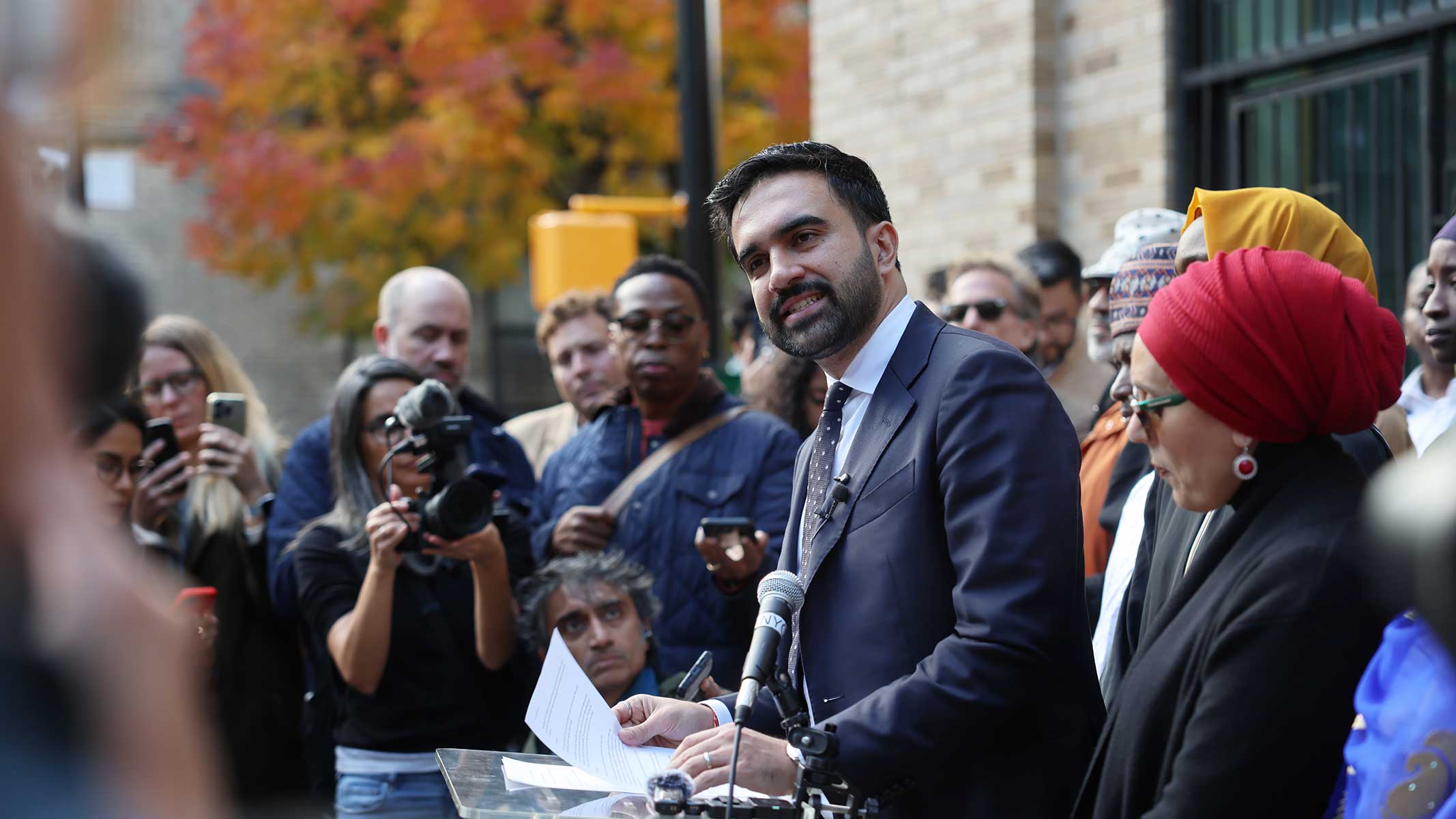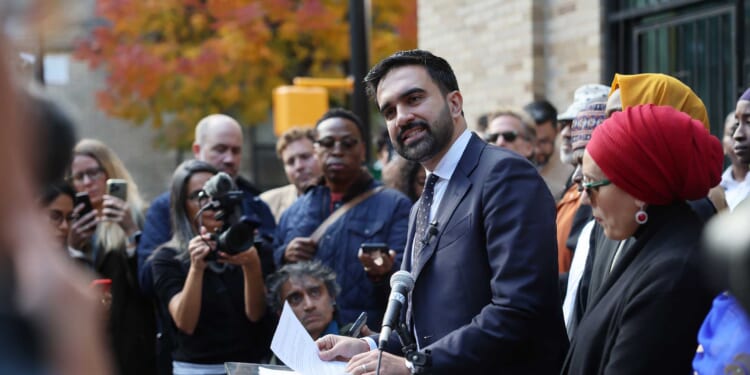
New York’s business executives and wealthy residents are scrambling to convince likely mayor Zohran Mamdani to be just a little nice to them next year. But if elected, Mamdani won’t carry out most of his government experiments on them—rather, his agenda would disproportionately affect middle-class and poorer New Yorkers, who may not be aware of the cascading potential consequences of these policies.
Take Mamdani’s proposed rent freeze. Here is all the candidate has to say about it in his platform, despite its being listed as his first goal: “Zohran will immediately freeze the rent for all stabilized tenants” for at least four years.
Finally, a reason to check your email.
Sign up for our free newsletter today.
The freeze isn’t the gift to the city’s nearly 1 million rent-regulated households that it appears to be. The obvious problem is that property owners’ costs would continue to rise; costs in rent-regulated buildings rose 3.8 percent between 2022 and 2023. Tenants who could have afforded a rent hike instead could see the upkeep in their apartment and building decline, as landlords abruptly cut costs. The 9.3 percent of rent-stabilized buildings considered “distressed” could see their landlords walk away from responsibility for the properties altogether—leaving them in limbo.
New Yorkers looking for a new apartment, too, could find dwindling supply, with property owners keeping vacant units indefinitely empty rather than leasing them to new tenants at a loss, as Mamdani’s chief rival, former governor Andrew M. Cuomo, pointed out at a late October debate. Already, owners keep tens of thousands of apartments off the market because it’s not worth it to rehab them for a below-market rent.
The biggest long-term risk to tenants, however, is that Mamdani’s radical proposed action—no rent hikes, by mayoral decree—would be met with an equally radical reaction.
New York’s rent-regulation regime is chronically imperiled by the prospect that the U.S. Supreme Court could declare it an unconstitutional “taking” of private property. The Court has declined recent New York cases, and existing precedent holds that limiting price increases through regulation is different from seizing property. But the increasingly conservative Supreme Court may see an indefinite rent freeze by mayoral whim as constitutionally different from a predictable system of regular rent increases under longstanding guidelines that weigh all parties’ interests—the needs of owners, tenants, and the public.
Mamdani is similarly blithe about reengineering another complex system: public transit. He would “permanently eliminate the fare on every city bus,” he says. What could be easier or more beneficial for the city’s 1.2 million bus riders—especially considering that nearly half of riders don’t pay anyway?
As with rent regulation, there’s an obvious problem. The state, not the city, controls the Metropolitan Transportation Authority and would make this decision.
But more complex problems also present themselves. To make investments in new train lines, to conduct major repairs, and to replace ever-aging trains and buses, the MTA borrows money by selling bonds.
To help give investors in these bonds confidence that the MTA will pay this debt, the MTA formally pledges its future fare revenues—including, explicitly, fares from buses—to its bondholders (much like mortgage borrowers pledge their homes).
The MTA cannot unilaterally cancel this fare pledge; it would need agreement from bondholders, and it could secure that agreement only by pledging an equally reliable future source of income, such as a new dedicated tax or toll.
Pledging future fare revenue isn’t just a legal nicety for the MTA’s investors, easily unwound by lawyers. It’s part of a four-decade-old social contract among investors, transit union workers, riders, and the government.
The MTA, beginning in the early 1980s, began raising fares on a regular basis so that inflation would not consume its revenues. As it asked riders to do more, the MTA asked taxpayers to do more, too, with the state legislature repeatedly enacting dedicated transit taxes. For 2026, the MTA will take in $9.1 billion in projected tax dollars, and just $5.5 billion in fares. (Even before Covid-19’s impact on ridership, taxes were gradually overtaking fares.)
Reliable tax and fare revenues have allowed the MTA to avoid cost-cutting, including slashing pay or benefits for union workers, and they have protected against the infrastructure deterioration that harmed the city’s commuters in the 1970s.
To suddenly snatch away a pillar of this system—all fare collection on buses, the region’s second-biggest form of transit behind the subways—would imperil the whole system.
It could set off a cascade of revenue loss. For one thing, part of Mamdani’s argument for eliminating bus fares—that many riders cannot afford them—also holds for the subways. Further, state leaders rarely give New York City a new benefit without also giving suburbanites an equivalent consideration. Suburban rail commuters, too, who pay far higher prices than subway and bus riders to commute, would likely demand and receive fare concessions from Governor Kathy Hochul, who is up for reelection next year.
Sacrificing bus fares thus risks eroding the MTA’s broader funding, both for day-to-day costs and large-scale investments. If the city discards a system that has worked well for 40 years without ensuring a workable alternative—one not yet detailed by Mamdani or anyone else—then those who depend on subways and buses would suffer worse service.
Mamdani’s proposal for a Department of Community Safety is the part of his platform with the greatest potential impact on poorer and middle-class New Yorkers. Here, at least, the candidate has a more detailed 17-page plan.
The centerpiece of that plan is to stop asking police “to deal with the failures of our social safety net.” Instead, Mamdani would move many police duties, including approaching people who appear to be disturbed on subways and streets, to a new civilian corps of mental-health and homeless-outreach workers.
The idea here is partly sound. In fact, it’s solid enough that the city and the state-run MTA already do this work, with small-scale new programs launched over the past two years.
One critical part of these initiatives has ensured modest success, compared with less effective outreach programs in the past. Through “co-response,” mental-health workers, when they approach individuals who seem to need intervention on the street or on subway platforms, are backed by police, who stand nearby.
The police are there to give civilian outreach workers confidence that, should a person become agitated or violent when approached, they will have protection against assault. Indeed, MTA chairman Janno Lieber recently told the New York Editorial Board that the clinicians on these teams “love the police.” Without police backup, these civilian outreach workers sometimes avoid interacting with people who appear severely agitated—the people most in need of help.
Without police backup, too, civilian outreach workers would have less recourse to a strategy favored by both Hochul and Adams: transporting people against their will to hospitals for psychiatric evaluation when warranted, including when they appear unable to meet their own basic needs.
But Mamdani is less certain about such involuntary hospitalizations, saying he would use them only as a “last resort” but not defining what that means. Without the option of involuntary hospital transport, civilian mental-health workers would have no choice but to let uncooperative people walk away.
Counterintuitively, then, Mamdani’s plan to scale up mental-health and homeless outreach requires more police officers, not fewer. It would be realistic for him to argue for a larger police force and a larger mental-health corps. But it’s not realistic to swap out some current police resources in favor of more civilians, as Mamdani proposes, and maintain the modest reductions in crime and public disorder that New York City has managed over two years.
On Mamdani’s stance toward the wealthy, two outcomes are possible. Big companies and rich people could tolerate his proposed tax increases, as Mamdani argues they would—in which case they wouldn’t bear the brunt of his untested platform. Or alternatively, some businesses and rich people wouldn’t or couldn’t accept his tax plans and would leave the city. Either way, they would be okay.
Non-wealthy New Yorkers, though, would be a captive audience for Mamdani’s anticipated bold experiments in governance.
Photo by Spencer Platt/Getty Images
Source link

















